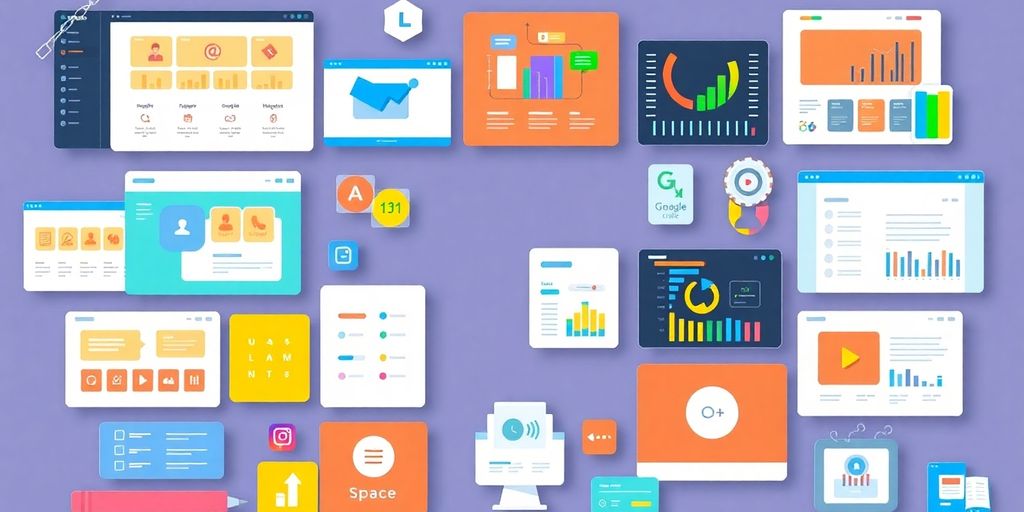How to Build an App with AI No Code: A Step-by-Step Guide

Creating an app with AI without needing to write code is now easier than ever. This guide will help you understand the process of using no-code platforms to build your own AI applications. Whether you have coding experience or not, you can follow these steps to bring your ideas to life and develop powerful apps that solve real problems.
Key Takeaways
- No-code platforms allow anyone to build apps without coding skills.
- Defining the problem your app will solve is essential for success.
- Choosing the right no-code platform is crucial for your app’s capabilities.
- Testing your app thoroughly ensures it works as intended before launch.
- Gathering user feedback helps improve your app over time.
Understanding AI No-Code Platforms

Creating apps used to require a lot of coding skills and resources, which can be tough for many people. But now, with no-code platforms, anyone can build an app without writing any code! These platforms are changing the game, making it easier for everyone to turn their ideas into reality.
Exploring the Benefits of No-Code Development
No-code development has several advantages:
- Accessibility: You don’t need to be a tech expert to create an app.
- Speed: Build apps faster without the need for coding.
- Cost-Effective: Save money by not hiring developers.
Key Features of AI No-Code Platforms
AI no-code platforms come with some powerful features:
| Feature | Description |
|---|---|
| Drag-and-Drop Interface | Easily design your app by dragging and dropping elements. |
| Pre-Made Components | Use ready-made parts to save time and effort. |
| Built-in AI Capabilities | Integrate AI features without needing to code. |
Choosing the Right Platform for Your Needs
When selecting a no-code platform, consider:
- User-Friendliness: Is it easy to navigate?
- Features: Does it offer the tools you need?
- Support: Is there help available if you get stuck?
No-code AI means using a no-code development platform with a visual, code-free, and often drag-and-drop interface to deploy AI and machine learning models.
With these platforms, building an app is as simple as putting together a puzzle. You can create amazing applications without any coding knowledge!
Setting Up Your Development Environment
Creating an Account on Your Chosen Platform
To start building your app, you first need to create an account on your selected AI no-code platform. Here’s how:
- Visit the platform’s website.
- Click on the Sign Up button.
- Fill in your details like email and password.
- Verify your email to activate your account.
Navigating the User Interface
Once your account is set up, familiarize yourself with the user interface. Most platforms have a similar layout:
- Dashboard: This is your main control center.
- Building Canvas: Where you design your app.
- Component Library: Contains all the elements you can add to your app.
Configuring Basic Settings
Before you start building, it’s important to configure some basic settings:
- Set your app’s name and description.
- Choose a theme that fits your app’s purpose.
- Adjust any privacy settings to control who can access your app.
Remember, a well-set environment is key to a smooth development process. Take your time to explore all the features available to you!
Designing the User Interface

Creating a great user interface (UI) is essential for your app’s success. A well-designed UI can make your app more enjoyable and easier to use. Here are some key aspects to consider:
Using Drag-and-Drop Tools for UI Design
- Choose a Template: Start with a pre-made template that fits your app’s purpose. This saves time and gives you a solid foundation.
- Drag-and-Drop Elements: Use drag-and-drop tools to add buttons, images, and text boxes to your app. This makes it easy to customize your layout.
- Preview Your Design: Regularly check how your app looks by using the preview feature. This helps you spot any issues early on.
Incorporating Responsive Design Elements
- Mobile-Friendly: Ensure your app looks good on both mobile and desktop devices.
- Flexible Layouts: Use flexible grids and layouts that adjust to different screen sizes.
- Test on Multiple Devices: Always test your app on various devices to ensure a consistent experience.
Customizing Themes and Styles
- Color Schemes: Choose colors that match your brand and appeal to your target audience.
- Fonts and Text Sizes: Select easy-to-read fonts and appropriate text sizes for better readability.
- Consistent Design: Keep your design elements consistent throughout the app for a professional look.
Remember, the user interface is the first thing users see. A clean and attractive design can keep them engaged and encourage them to explore your app further.
By focusing on these aspects, you can create a user-friendly interface that enhances the overall experience of your app. This is a crucial step in how to create an app using AI: a no-code guide that will help you succeed in your app development journey.
Integrating AI Features into Your App
Integrating AI into your app can greatly enhance its functionality and user experience. AI integration mainly involves setting up APIs for your app to interact with the model. Here’s how to do it step by step:
Selecting AI Components for Your App
- Identify the specific AI features you want to include, such as:
- Natural language processing for chatbots
- Image recognition for photo apps
- Predictive analytics for data-driven insights
- Research available AI APIs that fit your needs. Some popular options include:
- Google Cloud AI
- IBM Watson
- Microsoft Azure AI
Configuring AI Algorithms and Models
- Choose whether to run your AI model on the cloud or on the device. Cloud processing is often more powerful, while on-device processing can enhance privacy and speed.
- Set up the necessary APIs to connect your app with the AI model. This will allow your app to send and receive data seamlessly.
- Test the integration to ensure everything works smoothly and the AI features respond as expected.
Testing AI Functionality
- Conduct thorough testing to identify any issues. Focus on:
- Performance: Does the AI respond quickly?
- Accuracy: Are the AI predictions correct?
- User experience: Is the AI feature easy to use?
Integrating AI is not just about adding technology; it’s about improving the overall experience for your users. Make sure to gather feedback to refine your AI features continuously.
By following these steps, you can successfully integrate AI features into your app, making it more engaging and effective for users.
Testing and Debugging Your App
Testing your app is a crucial step to ensure it works well and meets user needs. Effective testing helps catch issues early. Here are the main types of testing you should focus on:
Running Simulations and Test Cases
- Unit Testing: This checks the smallest parts of your app. For example, if your app has an AI chatbot, you would test if it greets users correctly.
- Integration Testing: This tests how different parts of your app work together. It’s important to see how the AI model interacts with other features in real-life situations.
- User Acceptance Testing (UAT): This final test ensures your app meets user expectations. Involve a variety of users to get different feedback.
Identifying and Fixing Common Issues
- Feedback Loop: Create a way for users to give feedback. This helps you improve the app based on what users want.
- Common Problems: Look out for bugs, glitches, or slow performance. Fix these quickly to keep users happy.
- Testing Tools: Consider using tools like BrowserStack for automated testing. This can save time and effort.
Optimizing Performance and Speed
- Monitor Performance: Use tools to track how your app performs. Check response times and error rates.
- User Analytics: Analyze how users interact with your app. This can help you find areas to improve.
- Regular Updates: Keep your app updated based on user feedback and performance data.
By following these testing steps, you can ensure your AI app is effective and user-friendly. Continuous testing and updates will help maintain its relevance and performance.
Deploying Your App to the Market
Once your app is ready, it’s time to share it with the world. This step is crucial for turning your idea into a real product. Here’s how to do it:
Preparing Your App for Launch
- Research and Write Descriptions: Look for similar apps in the app store. Check their titles and descriptions for keywords. Use these keywords in your app’s description to help users find it.
- Create an Eye-Catching Icon: Your app icon should grab attention. Use tools like Looka to design a cool icon that stands out.
- Submit Quality Screenshots and Videos: Make sure your screenshots and videos clearly show how your app works. High-quality visuals can help convince users to download your app.
Submitting to App Stores
| Platform | Steps to Publish | Approval Time |
|---|---|---|
| Apple App Store | 1. Create an Apple developer account and pay the annual fee. 2. Use TestFlight for testing. 3. Follow the publishing instructions. | 24 to 48 hours |
| Google Play Store | 1. Create an Android developer account and pay the one-time fee. 2. Follow the publishing instructions. | A few hours to a few days |
Marketing and Promotion Strategies
- Social Media: Share your app on platforms like Instagram and Facebook to reach more users.
- Influencer Partnerships: Collaborate with influencers to promote your app.
- Email Marketing: Send out newsletters to inform potential users about your app’s launch.
After launching, your role shifts from builder to maintainer. Keep an eye on user feedback and analytics to improve your app continuously.
By following these steps, you can successfully deploy your app and start gaining users. Remember, the journey from idea to deployment is just the beginning!
Maintaining and Updating Your App
Keeping your app fresh and relevant is crucial for user satisfaction and retention. Regular updates not only enhance functionality but also address security issues and bugs. Here are some key steps to ensure your app remains effective:
Monitoring User Feedback and Analytics
- User surveys: Regularly conduct surveys to gather insights about user experiences.
- In-app feedback: Implement feedback forms to collect real-time input from users.
- Review analysis: Consistently check ratings and comments on app stores to understand user sentiment.
Implementing Updates and New Features
- Feature rollouts: Plan and introduce new features that improve user experience.
- Performance enhancements: Continuously optimize the app to reduce loading times and resource usage.
- Security patches: Stay alert for vulnerabilities and address them promptly through updates.
Ensuring Security and Compliance
- Data privacy: Regularly review your app’s data handling practices to ensure compliance with regulations.
- User data protection: Implement measures to safeguard user information against breaches.
- Regular audits: Conduct audits to identify and rectify potential security risks.
Keeping your app updated is not just about adding new features; it’s about creating a seamless experience for your users. By prioritizing a human-centered UX, you can ensure that your app meets the evolving needs of your audience.
Final Thoughts on Building AI Apps Without Code
In conclusion, creating AI apps without any coding skills is not just a dream; it’s a reality that anyone can achieve. This guide has shown you the essential steps to take, from defining the problem your app will solve to choosing the right no-code platform and continuously improving your app based on user feedback. Remember, the key is to stay curious and open to learning as you go. With the right tools and a bit of creativity, you can build an app that makes a difference. So, don’t hesitate to dive into the world of no-code AI app development and bring your ideas to life!
Frequently Asked Questions
Do I need to know how to code to create AI apps with no-code tools?
No, you don’t need any coding skills to create AI apps using no-code tools. These platforms are made to be easy for everyone, even if you have no tech background. However, knowing a little about how apps work and some basic AI ideas can be helpful.
How long does it usually take to make an AI app using no-code platforms?
The time it takes to build an AI app with no-code tools can vary. It depends on how complex your app is and how familiar you are with the platform. Some simple apps can be made in just a few hours, while more complicated ones might take weeks.
Can I add AI features to my app without coding?
Yes! No-code platforms let you easily add AI features like chatbots or recommendation systems to your app without writing any code. You can use built-in tools to set these up.
What should I do first when planning my AI app?
The first step is to figure out what problem your app will solve. Think about who will use it and how AI can help them. This clear idea will guide your whole development process.
Are no-code platforms really effective for building apps?
Absolutely! No-code platforms are very effective and allow anyone to create apps quickly and easily. They provide tools that simplify the development process, making it accessible for everyone.
How can I promote my app once it’s built?
Once your app is ready, you can promote it by sharing it on social media, submitting it to app stores, and using marketing strategies like online ads or partnerships to reach your audience.








Responses